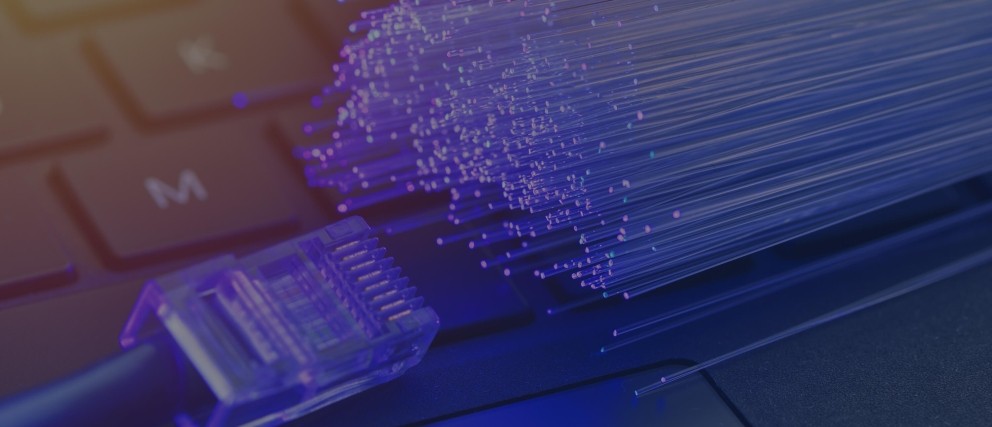
Quick Guide to Fiber Networking
Fiber optic cables are common in almost every network. Their ability to carry large amounts of data at the highest speeds makes them ideal for the backbones of most networks. They connect everything from computers and laptops, to cities and countries. Without them, we’d be stuck with copper cables, radio and microwave links, and satellite uplinks—none of which are as versatile, fast, or cheap as fiber cables.
Advantages of Fiber Vs. Copper Cables
Made from long thin strands of glass and covered in protective plastic coatings, fiber cables have many advantages over copper.
Security
Copper cables can be “tapped” because they emit electromagnetic signals, enabling hackers to eavesdrop on traffic without disturbing the cable. Intercepting traffic on a fiber optic cable is more difficult because no energy escapes the cable coating so cable tampering can be easily detected.* This makes fiber cables an attractive option for security-conscious organizations that want data protection from the network core to the desktop device. High-security environments like defense installations, banking, and other critical organizations that need the highest data protection should consider using a fiber to the desk (FTTD) architecture.
*Active Fiber Monitoring is a feature of Allied Telesis switches that detects changes in light levels on fiber cables, caused when cables are moved or disturbed during tapping.
Future Proof
Installing fiber ensures your network can keep up with the growth in traffic over time. A fiber cable can carry traffic at gigabit, 10G or 100G speed, which simplifies network upgrades without the need for expensive re-cabling. Unlike copper cables that need upgrading for higher speeds, fiber cables can keep pace with increasing network demands, which makes them perfect for applications that expect to add capacity in the future.
Distance
Copper cables can transmit data over a maximum distance of 300 feet (100m). Depending on the type of fiber cable, distances can range from 1,500 feet to several miles, enabling easier and cheaper deployments in large buildings and campuses.
Speed & Reliability
Fiber is immune from interference caused by machinery and fluorescent lights, so high-speed data transfer is more reliable in electrically noisy environments. Fiber also has fewer compatibility issues—if a network segment of copper uses a lower standard cable, it reduces the performance of the entire segment. For example, if a Cat5 patch cable is used in a Cat6a network, overall performance will degrade to the level of the Cat5 cable.
Fiber vs. Copper Cost Comparison
The cost of fiber cabling used to be higher than copper, but as demand has increased, manufacturing costs have dropped. Therefore, installation costs for fiber cables are comparable to copper.
Optical transceivers are required to “light up” the fibers and when the cost of these are included, the overall setup costs of fiber networking are more than copper. However once installed, the transceivers can be easily swapped out for higher capacity models without the need to upgrade the cables. So overall operational costs over the long term are lower with fiber than an equivalent copper network.
Considerations When Using Fiber & Copper Cables
Although fiber cabling has many advantages, copper is still commonly used in most networks, because of its ease of use and low cost. Fiber cables require special connectors too, so joining both types of cable is necessary. This is the function of a media converter—a small device with a copper port and a fiber port.
Media converters are easy to install and use. Many are Layer 1 network devices, making them entirely transparent to traffic, so they can be installed without affecting existing network configurations. Although media converters require no management because they are usually not configurable, some have functions that improve the manageability of the devices they connect.
Allied Telesis media converters provide features to improve troubleshooting and simplify network administration. MissingLink monitors network connections and provides notification of a failure making detection and resolution easier and faster. Remote Power Cycle enables the media converter to cycle PoE power when the fiber connection drops. This enables an administrator to remotely reboot the connected PoE device simply by controlling the fiber port on the upstream switch. This is very useful when an administrator needs to reset a device, like a VoIP phone or IP camera, without physically going to the remote location.
Your Partner for Fiber Networking
Allied Telesis has been building fiber networking solutions for almost 30 years. With more than two million units deployed within the United States government, our solutions are the only options to consider for secure and reliable fiber connectivity.
Want to learn more?
Related


